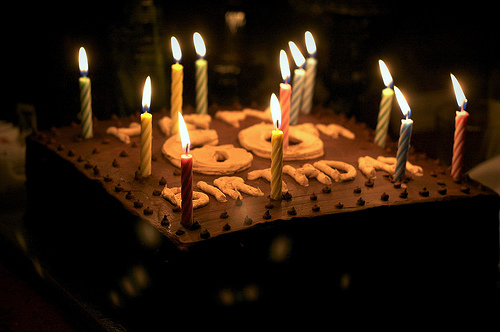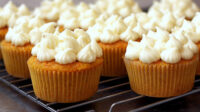My father-in-law, youthful guy that he is, turned 60 this past weekend and if you think I was going to allow my in-laws to purchase him a cake from a bakery, oh, you don’t know how even typing those words caused the shudder to rise up in my chest. A bakery cake! Promise me if I make it to 60, I get a homemade cake too. I hope to have leveraged enough cake-baking karma by then to not even have to ask.
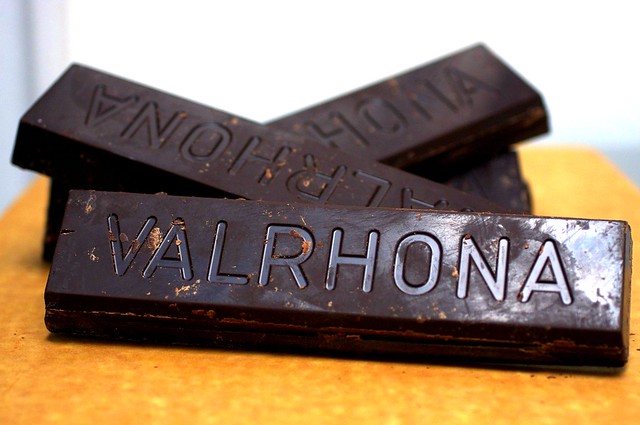
But this isn’t about my father-in-law’s birthday cake, or not entirely. (But you’ll see the recipe later, you know, just in case you ever want to make your own 12-inch square insanely chocolaty cake.) I am long overdue to share with you many of my favorite layer cake tips. I get a lot of email about them, people asking about the logistics of putting them together and I realize I’ve absorbed a lot of advice over the last fifteen or so, and I’m overdue to sum it up in one neat place. So here we go!
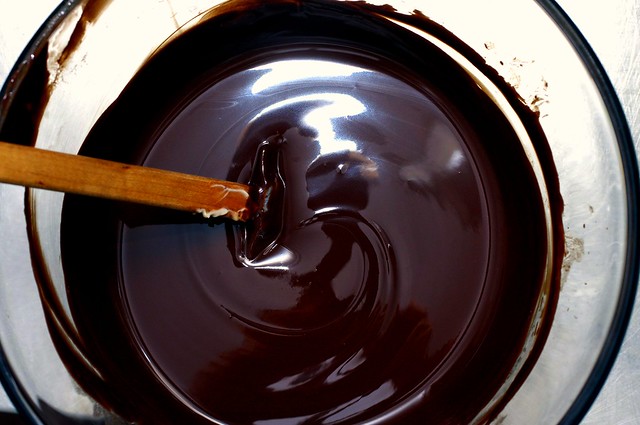
10 Tips for Better Layer Cakes
1. Why I am obsessed with the freezer: If you’ve read a few of my Celebration Cakes posts already, you’ve probably heard me mention the freezer, one, twice or possibly 32 times. I am clearly a little obsessed with the freezer when working with cakes and that’s for good reason: The freezer is your friend. Cakes are much easier to work with when frozen — from lifting layers to stack them, leveling the layers and even setting some frostings. How do you freeze a cake layer? I use the flash-freezing approach. I pop a single layer in the freezer either on a parchment- or waxed paper- lined tray or even still right on the cooling rack, make sure it isn’t touching a thing and freeze it until it’s solid — about 30 minutes to an hour. Once frozen, you can use it right away, or wrap it tightly in plastic until you need it again.
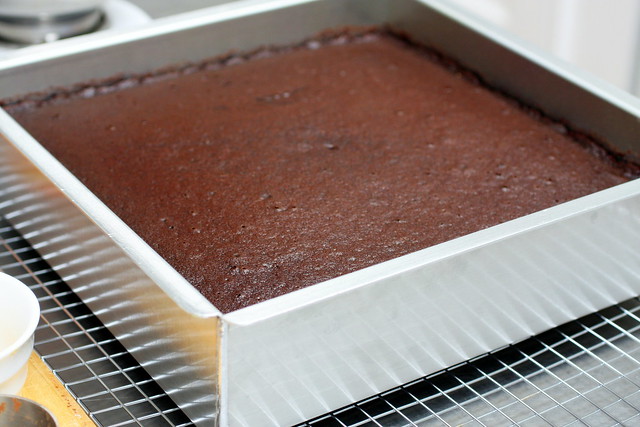
2. Baking even layers: If you’re going to stack one cake layer on top of another, you want the surfaces to be flat. A flat-bottomed cake layer on top of a rounded cake dome will inevitable crack, and I will inevitably throw a temper tantrum over that. It is infinitely avoidable. We’ll talk about leveling your cake next, but the best way to have less to level (and less scraps to “nom” on, because oh, you will, and then have no room for a real slice) is to bake them more evenly from the get-go. There are two ways to do this. The first is through Evenbake Cake Strips which are meshy metallic fabric strips that you dampen and pin around the outside of a cake pan before you put it into the oven. I’ll spare you the science behind it (like I get it, anyway) but they really are magical and your cake layers come out evenly. The second way to get your cakes to bake more level is the gadget-free way, and an old baker’s secret, but I would say that the results are a leetle less flat, yet still impressive. Simply bake the cake at a lower temperature (usually 300 instead of 350) for a longer period of time — that’s it!
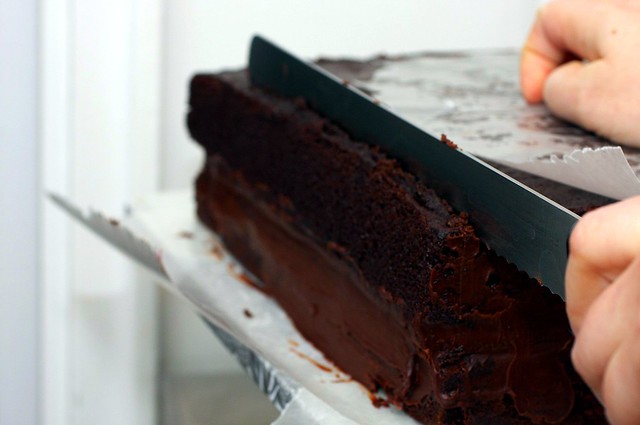
3. Leveling: So you’ve done everything in your power to get nice even layers but guess what? You’re baking, not building a cake out of styrofoam blocks (in case you’ve ever wondered why your cakes never look like those in the wedding magazines, I have now gleefully blown their cover) and there will be uneveness. This is when you bust out the longest serrated knife you own (I fell in love with this 12-inch F. Dick — oh lawsy, the Google searches I’ll get for that — when Torrie brought it over last summer and I had to buy my own. It is the very best serrated knife I have ever used in my entire life, and for a good knife, downright cheap.) and start trimming. Oh, I know some people use a level but for me, that’s one step beyond my level of insanity; I eyeball it instead. I also even out the sides. Inevitably, even when you stack two cake layers from the same recipe baked in the same pan, their edges will not perfectly meet and any place they do not meet, you’re stuck spackling them smooth with frosting. Or you could just use the same knife to trim the sides.
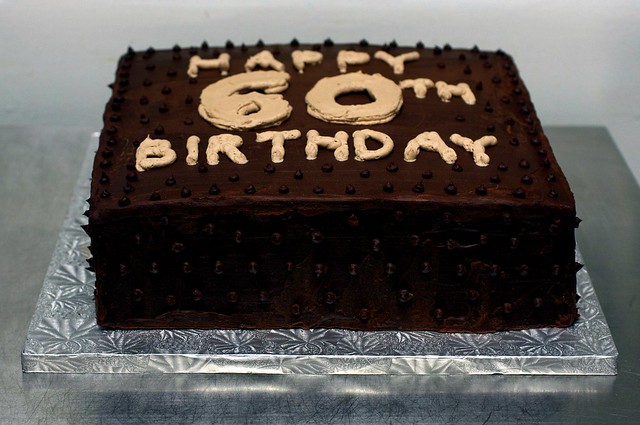
4. Cake boards: Cake boards are awesome — there is no easier way to transfer a cake from a box to a platter to the fridge to wherever you need to take it. Sure, you can cut your own from cardboard and, lo, I have done that many times when I forgot to buy one or grabbed the wrong size but if you have any kind of baking supply store near you (New Yorkers, check out New York Cake Supply on 22nd Street) they probably sell them for a quarter a pop. You can buy cheap cardboard ones or thicker, decorated ones depending on your usage; I actually buy extras because they’re useful to have around. What to look for? A board that is two inches bigger than your cake. This creates a one-inch border around the cake that, when slid into a box, protects the lovely decorated cake sides from damage. If you buy cake boxes, too (again, super-inexpensive, $1 to $2 a pop or you can just go to your local bakery and beg them to sell you one), you’re looking for a size that matches not the cake, but that two-inch larger board.
5. Keeping your cakes moist: Let’s just say, for a completely random example, that you’re making a wedding cake and you’re concerned that in the time between you begin and finish off the cake, the cake might dry out a little. Brushing it with a simple syrup, one part water to sugar, or even three parts water to one part sugar (if you’re concerned about the cake getting too sweet) before you start decorating it is the best way to avoid this. Heck, I have rarely seen a layer cake that wasn’t improved by a little extra moisture. But there’s no need to be boring: you can add citrus zest or juice to flavor the syrup (or boil the syrup with a citrus peel inside), a shot of liquer or your favorite extract or any flavoring you can think of. It is especially fun to use it to complement the flavor of the cake. Want to know another secret? When I made the wedding cake, I didn’t even use a syrup on the chocolate layer, just a little water with vanilla in it.
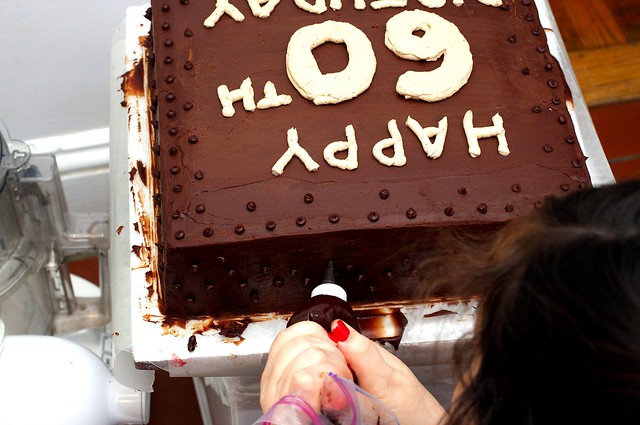
6. Strips of waxed paper: So your cake layers are baked and you’re ready to start decorating. You gently lower your frozen cake layer onto the center of your cake board (see how easy that was when it was cold?) and you are about to get out the filling and frosting but wait! Before you take out anything else that will mess up your cake board (which you’ll probably be serving the cake on, so you want it to stay nice), slip little pieces of waxed paper underneath the edge of the cake all around its circumference until the board is covered. No matter how much of a mess you make decorating, the board still looks shiny and new when you’re completely done and remove them.
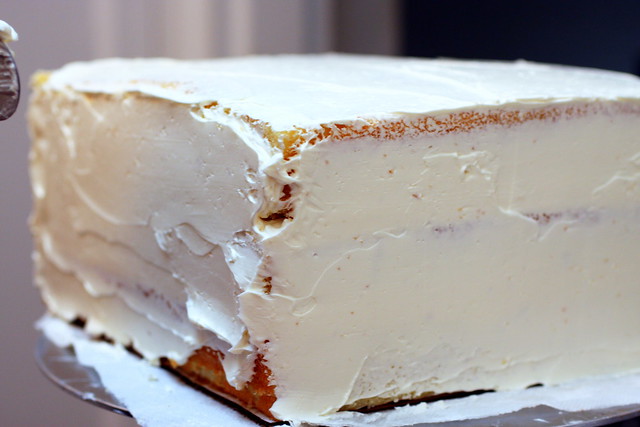
7. Crumb coating/masking: If you take not one other thing away from this post, at least promise to remember this. The difference in the appearance of cakes iced by professionals and those iced by home cooks almost always comes down to the presence or absence of a crumb coat. The crumb coat is a thin layer of frosting that is the “base coat” if you will. It sort of glues the crumbs into the cake (especially important for dark cakes with light frostings) and primes the cake for the thicker, smoother layer to follow. No need to make this coat perfect, but you do want to make sure you cover every crumb of the exposed cake or they will sneak through, trust me. Once you’ve finished masking the cake with the crumb coat, you can set it in the fridge for 30 minutes to an hour before adding the final coat. It will go so much more smoothly than you’re probably used to.
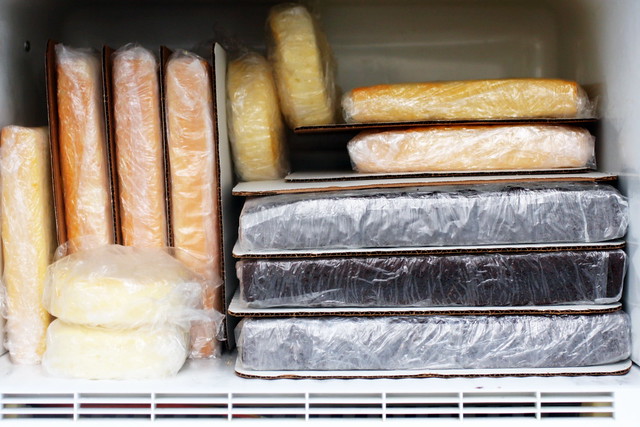
8. Stuff that can be done in advance: Baking your cake layers. (Triple-wrapped in plastic and frozen, you can bake layers weeks in advance.) Creating some fillings. (Curds keep especially well in the fridge, often for a week or longer.) Creating some frostings. (I have the greatest success with Swiss Buttercream, which you can leave out at room temperature for a whole day without anything bad happening, or a crust forming. Presuming you don’t live in a sauna, that is.). Often, making the whole cake. (Most finished cakes will keep moist and lovely in a fridge for at least a day.)

9. Pan Size Conversions Say you want to make this 12-inch cake into a sheet cake, a 9-inch circle into an 8-inch square, a bundt into cupcakes… This cake pan size conversion chart will show you what’s feasible, and what needs to be scaled.
10. Resources: Despite all of this, and a wedding cake too, I am no cake expert. At best, I am a cake dilettante, and the amount of advice I am confident giving is limited to what you see on this page. If you have questions beyond this, the best place to get good answers are the Wilton boards (those people know their stuff!) and site (they have excellent guides) or to get a good cake book. I would say that Rose Levy Beranbaum’s Cake Bible is probably the best of the books, but I have also not looked at many beyond it. I have yet to meet a person who regretted the $23 purchase.
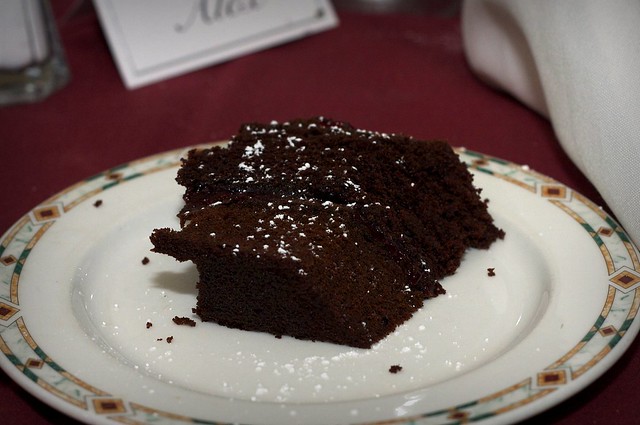
One year ago: White Bean Stew
Two years ago: Italian Bread
FAQ Page: I love getting email, and I’m lucky because I get a lot of it. I also like to think that I have good manners (or unhealthy compulsions, but really, doesn’t “manners” sound a lot better?) because I try to respond to all of it. And then there are days that I look up and realize that I’ve spent half of it emailing and not, say, meeting deadlines/ testing recipes / updating this here site — whoops! And that, you see, is the very long introduction to this even longer FAQ page, in which I hope to cover the territory of most of the emails I get. Does this mean I don’t want you to email me anymore? Not one bit. But if it was a quick question, who knows, maybe I already answered it. Instead you can email to tell me how nice my hair looks that day. [FAQ Page]
Giant Chocolate Butter Cake with Raspberry Filling and Brandied Bittersweet Ganache
Adapted from Sky High Cakes: Irresistible Triple-Layer Cakes
The components of this cake may look familiar. We used the cake recipe for the bottom tier of the wedding cake (that post contains the recipe for a regular-sized version of the cake), though three layers tall when this one is only two (I didn’t think a birthday cake needed the height/grandiosity of a wedding cake) and the filling we used on those layers (Brandied Bittersweet Ganache) was actually the frosting on this (though realizing I’d made extra, I put a little between the layers too).
I go back and forth between this chocolate layer cake and that from the Double Chocolate Layer Cake. That one is, hands down, the most incredible chocolate layer cake — it’s insanely moist and soft and light-tasting and nobody who has made it regretted it. However, this cake also has its glories; it’s sturdier but still moist, it’s practically a one-bowl recipe and it’s a lot easier to work with because it’s not so soft that if you pick it up, you’ll end up with a handful of crumbs. (The downside of an extremely soft cake, if there could ever be one.) For large cakes and wedding cakes, or if you find soft cakes hard to work with, this is the one to use.
Last note/warning: This yields a ridiculous amount of batter, too much for my 5 quart Kitchen Aid or any of my bowls. I halve it and make the batches of batter separately.
Cake Layers
5 1/3 cups cake flour
5 1/3 cups sugar
2 2/3 cups unsweetened cocoa powder, not Dutch process
6 1/2 teaspoons baking soda
1 1/4 teaspoons ground cinnamon
1 1/2 teaspoons salt
5 1/3 sticks (20 2/3 ounces) unsalted butter, at room temperature
2 2/3 cups buttermilk
5 large eggs plus 1 large egg yolk
2 2/3 cups freshly brewed coffee, cooled to room temperature
1 cup seedless raspberry jam (for cake assembly)
1. Preheat the oven to 350 degrees F. Butter two 12-inch square cake pans. Line the bottoms with parchment or waxed paper and butter the paper.
2. In a large mixer bowl, combine the flour, sugar, cocoa, baking soda, cinnamon, and salt. With the electric mixer on low speed, blend for about 30 seconds. Add the butter and buttermilk and blend on low until moistened. Raise the speed to medium and beat until light and fluffy, 2 to 3 minutes.
3. Whisk the eggs and coffee together, and add to the batter in 3 additions, scraping down the sides of the bowl and beating only until blended after each addition. Divide the batter among the two prepared pans; each pan will take about 5 1/2 cups of batter.
4. Bake for 50 to 55 minutes, or until a cake tester or wooden toothpick inserted in the center comes out clean. Carefully turn them out onto wire racks and allow to cool completely. Remove the paper liners only when they are cool.
Brandied Bittersweet Ganache [Makes approximately 6 cups]
2 pounds bittersweet chocolate, broken up
2 sticks (8 ounces) unsalted butter, cut up
2 cups heavy cream, heated slightly to remove the chill
1/2 cup brandy or Cognac
1. Place the chocolate and butter in a large heatproof bowl. Set the bowl over a pot of barely simmering water. As the chocolate and butter melt, stir to blend.
2. When completely melted, remove from the heat and whisk in first the cream and then the brandy. Be sure to scrape down the bowl well and mix thoroughly. Allow to cool and thicken to the consistency of mayonnaise.
Assemble the Cake
1. Place one 12-inch layer on a 14-inch cake board. Use a long serrated knife to level it if has domed a bit on the top. Spread one cup of ganache thinly over cake layer (optional, you can have a raspberry-only filling too). Once it sets (if your cake is cold, this will be quick, otherwise put it in the fridge for a bit) spread the jam over the ganache.
2. Carefully place the second layer on top of the filling. Use the knife to even out any edges that overhang or don’t smoothly meet. Spread a thin layer of ganache over the top and sides of the cake, covering all of the crumbs. Let it set. Once set, spread the remaining ganache over the tops and sides. [I had some extra, and put it in a piping bag with a thin round tip to make the dots. You’ll only need a little.]

